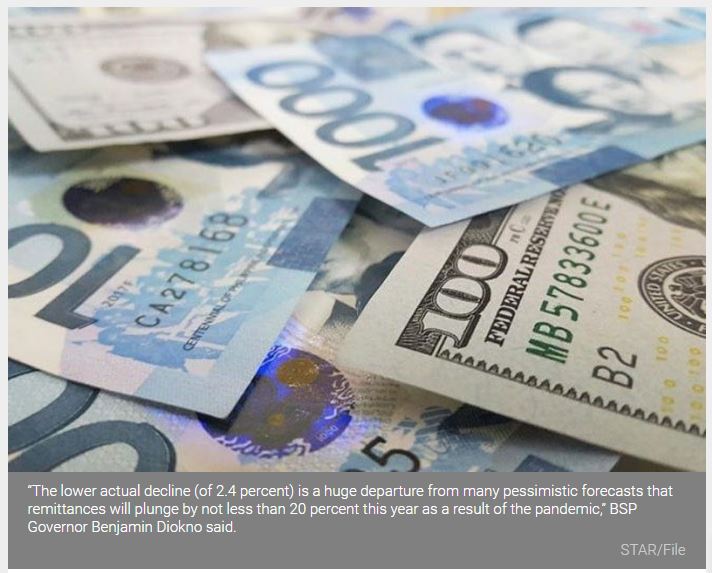Philippines: Remittances down 2.4% in 7 months
MANILA, Philippines — Remittances from overseas Filipino workers (OFWs) declined by 2.4 percent to $16.08 billion from January to July compared to $18.66 billion in the same period last year, according to the Bangko Sentral ng Pilipinas (BSP).
“The lower actual decline (of 2.4 percent) is a huge departure from many pessimistic forecasts that remittances will plunge by not less than 20 percent this year as a result of the pandemic,” BSP Governor Benjamin Diokno said.
For July alone, remittances grew by 7.6 percent to $3.08 billion from $2.87 billion a year ago, hitting the highest level in seven months as host countries continued to relax the mobility restrictions amid the COVID-19 pandemic.
This was the fastest increase since the 7.7 percent expansion recorded in October last year, and the highest since the $3.22 billion recorded in December.
Diokno attributed the growth to the 12.6 percent increase in remittances from land-based workers with work contracts of one year or more to $2.467 billion in July from $2.192 billion in the same month last year.
On the other hand, the BSP chief said remittances from sea-based workers fell by 9.2 percent to $557 million in July from $613 million a year ago due mainly to the repatriation of sea-based workers amid the pandemic.
Cash remittances coursed through banks rose for the second straight month at 7.8 percent to $2.78 billion in July from $2.58 billion in the same period last year.
This was also the fastest increase since the eight percent rise recorded in October last year and the biggest since the $2.9 billion inflow recorded in December last year.
The BSP said growth was mainly due to the 12.6 percent increase in land-based workers’ remittances, but was slightly tempered by the 9.2 percent decrease in sea-based workers’ remittances.
From January to July, cash remittances contracted by 2.4 percent to $16.8 billion from $17.22 billion in the same period last year.
According to the BSP, cash remittances from land-based workers slipped by 1.5 percent to $13.23 billion in the first seven months from $13.43 billion a year ago, while remittances from sea-based workers declined by 5.8 percent to $3.57 billion from $3.79 billion.
By country source, remittances from the US, Japan, Singapore, Qatar and Taiwan continued to climb, while declines were noted in Saudi Arabia, United Arab Emirates, Germany, Kuwait and the United Kingdom.
The highest share to total remittances at 40.1 percent during the seven-month period came from the US, followed by Singapore, Saudi Arabia, Japan, the United Kingdom, United Arab Emirates, Canada, Qatar, Hong Kong and Taiwan for a total combined share of 78.9 percent.
Union Bank chief economist Ruben Carlo Asuncion said many were expecting that remittances would return to negative growth after the surprise 7.7 percent growth in June.
“This tells you that our overseas Filipinos, the new era heroes, are continuing to send back. The back-to-back positive prints bode well for the prospects full year average moving forward. It does confirm our expectation that these
host countries, from mostly where these inflows come, are recovering and the likelihood of economic recovery is consistently rising,” Asuncion said.
Asuncion, however, remained cautious, at this point, but ‘’dancing with the virus is key moving forward.”
ING Bank Manila senior economist Nicholas Mapa said remittances, after defying expectations for the second month in July, are expected to weaken anew amid more displacements and market challenges in the coming months.
“We continue to pencil in a return to weakness or at best a moderating in the growth posted in the past two months as job market challenges and layoffs make it difficult for overseas Filipinos to send home more funds in the coming months,” Mapa said.
The BSP expects remittances to drop by five percent this year.
Source: https://www.philstar.com/business/2020/09/16/2042665/remittances-down-24-7-months


 English
English




